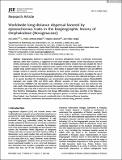Por favor, use este identificador para citar o enlazar a este item:
http://hdl.handle.net/10261/247838COMPARTIR / EXPORTAR:
 SHARE SHARE
 CORE
BASE CORE
BASE
|
|
| Visualizar otros formatos: MARC | Dublin Core | RDF | ORE | MODS | METS | DIDL | DATACITE | |

| Título: | Worldwide long-distance dispersal favored by epizoochorous traits in the biogeographic history of Omphalodeae (Boraginaceae) |
Autor: | Otero, Ana CSIC ORCID; Jiménez-Mejías, Pedro CSIC ORCID; Valcárcel, Virginia; Vargas, Pablo | Fecha de publicación: | 2019 | Editor: | Chinese Academy of Sciences | Citación: | Journal of Systematics and Evolution 57: 579- 593 (2019) | Resumen: | Biogeographic dispersal is supported by numerous phylogenetic results. In particular, transoceanic dispersal, rather than vicariance, is suggested for some plant lineages despite current long distances between America and Europe. However, few studies on the biogeographic history of plants have also studied the role of diaspore syndromes in long-distance dispersal (LDD). Species of the tribe Omphalodeae (Boraginaceae) offer a suitable study system because the species have a wide variety of diaspore traits related to LDD and different lineages conform to patched worldwide distributions on three distant continents (Europe, America and New Zealand). Our aim is to reconstruct the biogeographical history of the Omphalodeae and to investigate the role of diaspore traits favoring LDD and current geographic distributions. To this end, a time-calibrated phylogeny with 29 of 32 species described for Omphalodeae was reconstructed using biogeographical analyses (BioGeoBEARS, Lagrange) and models (DEC and DIVA) under different scenarios of land connectivity. Character-state reconstruction (SIMMAP) and diversification rate estimations of the main lineages were also performed. The main result is that epizoochorous traits have been the ancestral state of LDD syndromes in most clades. An early diversification age of the tribe is inferred in the Western Mediterranean during late Oligocene. Colonization of the New World by Omphalodeae, followed by fast lineage differentiation, took place sometime in the Oligocene-Miocene boundary, as already inferred for other angiosperm genera. In contrast, colonization of remote islands (New Zealand, Juan Fernández) occurred considerably later in the Miocene-Pliocene boundary. | Versión del editor: | http://dx.doi.org/10.1111/jse.12504 | URI: | http://hdl.handle.net/10261/247838 | DOI: | 10.1111/jse.12504 | Identificadores: | doi: 10.1111/jse.12504 issn: 1759-6831 |
| Aparece en las colecciones: | (RJB) Artículos |
Ficheros en este ítem:
| Fichero | Descripción | Tamaño | Formato | |
|---|---|---|---|---|
| jse.12504.pdf | 1,4 MB | Adobe PDF |  Visualizar/Abrir |
CORE Recommender
Page view(s)
44
checked on 27-abr-2024
Download(s)
107
checked on 27-abr-2024
Google ScholarTM
Check
Altmetric
Altmetric
NOTA: Los ítems de Digital.CSIC están protegidos por copyright, con todos los derechos reservados, a menos que se indique lo contrario.
